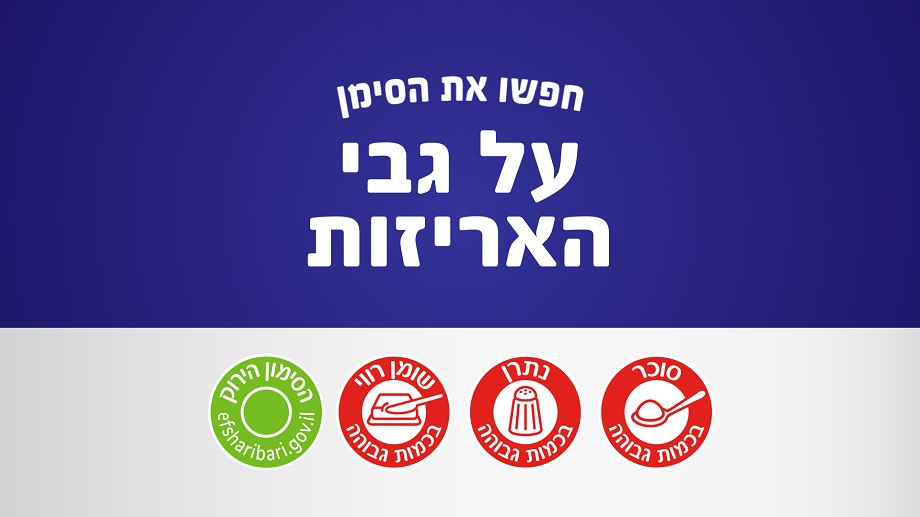
Red food symbols
High in High in High in
Saturated fats Sodium Sugar
Every food product sold in the country should have a kind of “ID card” that allows us, the consumers, to know what the product is made of and who the supplier is and decide whether we want or even can purchase it. This ID is made of several parts, all of which are required by law and regulations updated every few years – the latest, updated version was approved on December 2017.
Public Health Protection Regulations, Nutrition Labeling 5778-2017 (Hebrew)

In addition to information about the product’s title and contents, production and expiration dates, country of production etc. there are two significant sections that can help us compare similar products in the category and choose the healthier option: the list of ingredients and nutritional labelling.
What does the product contain? List of ingredients
Food suppliers and importers are obliged to specify all compounds and ingredients that a product contains. But it is important to know that the ingredients must also be written in descending order, according to their relative weight content. That is, the ingredient with the highest quantity in the product will appear first on the list of ingredients, and the lowest will be last.
For example, in a chocolate-flavored or nut-flavored cream where the first ingredient on the list is sugar – there is more sugar in the product than any other ingredient. Products “containing whole grains”– it’s important to check if the first ingredient on the list is regular or whole grain flour, so that you know what flour is contained in the product. Similarly, we can look at ready-made salads and spreads where the first ingredient on the list is oil rather than vegetables or herbs. Reading the list of ingredients will help to compare options in the same category – and choose a healthier one.
Ingredient list: read, compare and make a healthier choice
| Chocolate or nut flavored spread | If the first ingredient on the list is sugar – the product has more sugar than any other ingredient |
|---|---|
| Products “containing whole grains” such as cereals, bakery good, waffles, crackers etc. | It’s important to check if the first ingredient on the list is white (regular) or whole grain flour, so that you know what flour the product has more of. |
| Ready-made salads and spreads | Check if the first ingredient is vegetable oil which is less recommended than vegetables, legumes and herbs. |
The level of food processing (how much food that cannot be found in the local supermarket or in a typical home kitchen has been added) can be deduced from the list of ingredients: such as flavoring and food additives, e.g. food coloring, preservatives, stabilizers etc. will be listed on the ingredient list. There are supplements (such as tartrazine, sulfites) that are labeled with their explicit name and the name of the group to which they belong, depending on their primary purpose.
Nutrition labeling
This is the familiar table that lists the calorific value, protein, carbohydrate, fats and sodium content. Suppliers are also committed to listing cholesterol, saturated fat and trans fatty acids.
The nutrition table should appear on the food packaging in a conspicuous place, in the form of a table and in the order that appears in the Food Service Regulations, or – in small packages, on the list. In order to enable comparison of products, it is stated that the values on the packaging must be on an equal basis: in solid foods the content of the nutrients will refer to 100 grams of food, while in liquid foods to 100 milliliters. Additional specifications can be added to this requirement, such as: the contents of the nutritional components in a whole package (e.g. in a bag or cup) in a serving (one slice of bread), and more.
Comparing similar products in a category also allows for a healthier choice. For example, you may find that in some yogurts there is large variance in the calories and carbohydrates content – that is, they contain a lot of added sugar. Among different cereals there is significant variance in caloric value for the same size of serving. Sometimes the differences are actually less than expected – such as “no added sugar” versions of such brands. In many cases it turns out that the variance in caloric value is negligible.

Seek the symbols on packages (from right to left): high levels of sugar; high levels of sodium; high levels of saturated fat; the green label
Red symbol for harmful foods
In January 2020, all food products containing sugars, saturated fat, and sodium (salt) higher than the prescribed quantities will appear on red, clear symbols that clearly and prominently define them as harmful food products. This is a breakthrough move by the Ministry of Health as part of its activities in the National EfshariBari Plan, which was accepted as part of the recommendations of the Ministry's Regulatory Board and received the Knesset's seal of approval in December 2017 after lengthy and extended discussions.
Further reading:
Public Health Protection Regulations, Nutrition Labeling, 5778-2017 (Hebrew)
"Chile's Law on Food Labeling and Advertising: A Replicable Model for Latin America?"
Guide to buying safe food on the Ministry of Health Hebrew Website



